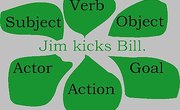Recognizing sentence fragments is relatively simple, yet many people struggle with it. Many people get confused because we generally speak in sentence fragments in daily conversation. Also, with the rise of text messaging and instant messaging, there are more opportunities to write run-on sentences and sentence fragments. These easy steps will help you spot those fragments.
Read aloud. If you read the sentence aloud and feel confused, then you most likely have a sentence fragment. Use the following tests to determine whether or not your sentence is a sentence fragment.
Find the verb. “Bob ran down the road.” The verb is the action. In this case, “ran” is the verb. If the sentence has a verb, then your sentence has passed the first test.
Locate the subject. The next sentence fragment test is to determine if your sentence has a subject. In the sentence, “Bob ran down the road,” the subject is “Bob.” Your sentence has passed test number two.
Check for completeness. If the sentence read, “Because Bob ran down the road,” then that sentence would fail the third test. This sentence begins with a subordinate clause (a word or phrase such as “When” or “Because”). You would need to add more to this sentence to clarify the subordinate clause “because.”
Tip
Check the punctuation. Often, sentences are inadvertently punctuated where they shouldn’t be and this creates a sentence fragment.
Tip
Use a word processor’s spell and grammar check feature to locate sentence fragments.
Warning
Don’t turn in an academic paper with sentence fragments. These pesky little incomplete sentences drive English teachers crazy.
Warning
Don’t trust your word processor to pick up every sentence fragment.
Related Articles
Tips
- Check the punctuation. Often, sentences are inadvertently punctuated where they shouldn’t be and this creates a sentence fragment.
- Use a word processor’s spell and grammar check feature to locate sentence fragments.
Warnings
- Don’t turn in an academic paper with sentence fragments. These pesky little incomplete sentences drive English teachers crazy.
- Don’t trust your word processor to pick up every sentence fragment.
Writer Bio
Karen Silvestri is an English professor at Palm Beach State College in Lake Worth, Fla., and has been writing professionally since 1997. She also leads workshops on memoir writing, journaling, creative writing and poetry in her community and online. Silvestri holds a Bachelor of Arts in English, and studied business and education at the graduate level.











